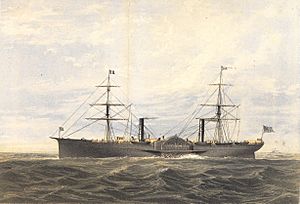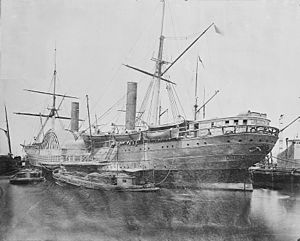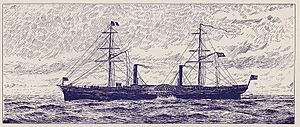SS Fulton (1855) facts for kids

U.S. Mail Steamer Fulton, J. A. Wotten, Commander.
|
|
Quick facts for kids History |
|
|---|---|
| Name | Fulton |
| Namesake | Robert Fulton, American engineer and inventor |
| Owner | New York & Havre Steam Navigation Company |
| Operator | J. A. Wotten, J. K. Mitchell, C. H. Townsend, J. B. Hildreth |
| Port of registry | United States 1855-1869 |
| Builder | Smith and Dimon Shipyard |
| Launched | September 4, 1855 |
| Completed | 1855 |
| Maiden voyage | September 4, 1855 |
| Fate | Sold |
| Notes | She had three decks, could accommodate 300 first-and second-class passengers |
| General characteristics | |
| Type | Wooden-hull Sidewheel steamer |
| Tonnage | 2,500 GRT |
| Length | 290 ft 0 in (88.39 m) |
| Beam | 42 ft 5 in (12.93 m) |
| Depth of hold | 31 ft 5 in (9.58 m) |
| Installed power | Two oscillating steam engine by Morgan Iron Works of New York |
| Propulsion | Iron Paddle Wheels, 33 feet diameter |
| Speed | 12 knots (22 km/h) |
The Fulton was a large wooden ship built in 1855. She was a sidewheel steamer, meaning she used big wheels on her sides to move through the water. The ship was built in New York City by the Smith and Dimon Shipyard.
The Fulton was owned by the New York & Havre Steam Navigation Company. She was used to carry passengers and goods across the Atlantic Ocean. During the American Civil War, the Union Army used her as a transport ship. After the war, she went back to carrying people and cargo.
Contents
Building the Fulton
The Fulton was built in 1855 by the Smith and Dimon Shipyard in New York. She was launched into the water on September 4, 1855.
Her sister ship was called the Arago. Both ships were built for the New York & Havre Steam Navigation Company. This company had a special agreement with the U.S. Government to deliver mail between New York and Le Havre, France.
The Fulton was named after Robert Fulton, a famous American engineer and inventor. Both the Fulton and the Arago were considered much better than older ships of their time. They had special engines and strong walls to protect them from rough seas.
The Fulton could carry 300 first and second-class passengers. She also had space for 700 tons of freight and 800 tons of coal. From 1858 to 1869, the Fulton was officially listed in the Record of American and Foreign Shipping. Her home port was the Port of New York.
Fulton's Journeys
The Fulton started her first trip on February 9, 1856. She worked as a mail steamer, carrying people, goods, mail, and valuable metals like gold. Her route went from Southampton, New York, to Liverpool, England, and then to Le Havre, France.
When the American Civil War began, the government stopped its mail service contracts. The Fulton's last trip as a mail carrier was on March 30, 1861.
The Civil War Years
From 1861 to 1865, the U.S. Department of War rented the Fulton. They used her as an army transport ship. It cost 1,200 dollars per day to charter her.
She made many trips from New York to ports along the Southern coast. Thousands of soldiers traveled on her. The Fulton also helped with the Union Blockade during the war.
On April 15, 1865, the Fulton left New York heading to Port Royal, South Carolina. She carried the sad news of President Abraham Lincoln's death. Her flag was lowered to half-mast to show respect. The officers at Port Royal were very sad to hear about the President's assassination.
On June 29, 1865, the Fulton arrived back in New York from Port Royal. She brought the 14th Regiment of soldiers. The Fulton continued to transport troops, equipment, and mail until the war ended.
After the War
After the war in 1865, the Fulton returned to her old route between New York and Le Havre. She continued on this route until the fall of 1867, when she stopped service.
In 1868 and 1869, the Fulton and her sister ship Arago were briefly rented by the Ruger Brothers. They tried to use them for passenger service again. However, without the government's mail money, both ships were too expensive to run. Newer, more efficient ships were also competing with them. The Fulton was later used as a hospital transport at the New York quarantine station.
The End of Her Service
In 1869, the Fulton was no longer considered safe to sail. She was taken apart and sold for scrap.



